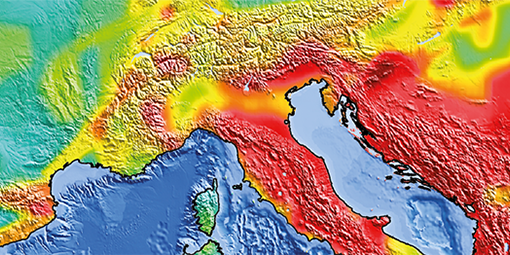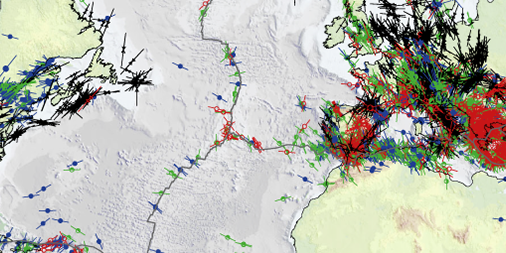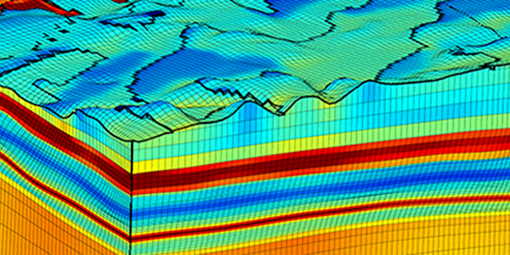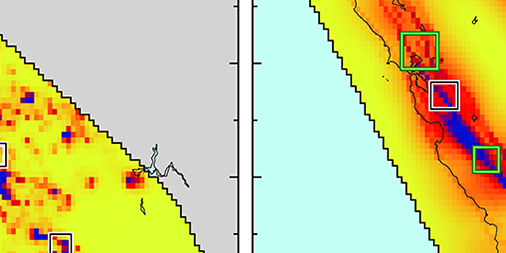Sektion 2.6: Erdbebengefährdung und dynamische Risiken
Das Ziel der Sektion ist es, modernste Verfahren zur verbesserten Beurteilung der probabilistischen seismischen Gefährdung bereitzustellen.
Wir analysieren die Stabilität von Bruchsystemen für Energietechnologien und führen Feldexperimente zur Bruchausbreitung und Störungsreaktivierung durch (Kontakt Arno Zang).
Wir entwickeln 4D Spannungsmodelle des Erdbebenzyklus für Inter- und Intraplatten-Regionen sowie für Endlagersysteme und managen das World Stress Map Projekt (Kontakt Oliver Heidbach).
Wir entwickeln ortsabhängige, physikalisch basierte und daten-orientierte Erschütterungsmodelle zur Verbesserung der Vorschriften für erdbebengerechtes Bauen (Kontakt Dino Bindi).
Wir berechnen seismische Gefährdungseinschätzungen auf der Grundlage konsistenter probabilistischer Berücksichtigung aller Eingangsdaten und transparenter Bewertung epistemischer Unsicherheiten (Kontakt Graeme Weatherill).
Wir entwickeln Methoden zum Testen der Komponenten und Ergebnisse von seismischen Gefährdungs- und Risikomodellen (Kontakt Danijel Schorlemmer)
Wir entwickeln dynamische Expositionsmodelle (Kontakt Danijel Schorlemmer) und tragen zu integrierten Risiko- und Frühwarnentwicklungen im urbanen Ballungsräumen bei (Kontakt Marco Pilz).
Aktuelle Veröffentlichungen
Dallo I, Marti M, Valenzuela N, Crowley H, Dabbeek J, Danciu L, Zaugg S, Cotton F, Giardini D, Pinho R, Schneider JF, Beauval C, Correia AA, Ktenidou OJ, Mäntyniemi P, Pagani M, Silva V, Weatherill G, Wiemer S (2024) The communication strategy for the release of the first European Seismic Risk Model and the updated European Seismic Hazard Model. Natural Hazards and Earth System Sciences 24(1): 291-307. https://doi.org/10.5194/nhess-24-291-2024
Mathur B, Hofmann H, Cacace M, Hutka GA, Zang A (2024) Thermo-hydro-mechanical simulation of cooling-induced fault reactivation in Dutch geothermal reservoirs. Netherlands Journal of Geosciences 103: e1. doi.org/10.1017/njg.2023.12
Nguyen TS, Kolditz O, Yoon JS, Zhuang L (2024) Modelling the thermo-mechanical behaviour of a rock joint. Geomechanics for Energy and the Environment 37: 100520. https://doi.org/10.1016/j.gete.2023.100520
Pilz M, Roux P, Mohammed SA, Garcia RF, Steinmann R, Aubert C, Bernauer F, Guéguen P, Ohrnberger M, Cotton F (2024) Wind turbines as a metamaterial-like urban layer: an experimental investigation using a dense seismic array and complementary sensing technologies. Frontiers in Earth Science 12. https://doi.org/10.3389/feart.2024.1352027
Rajabi M, Ziegler M, Heidbach O, Mukherjee S, Esterle J (2024) Contribution of mine borehole data toward high-resolution stress mapping: An example from northern Bowen Basin, Australia. International Journal of Rock Mechanics and Mining Sciences 173: 105630. https://doi.org/10.1016/j.ijrmms.2023.105630
Su Z, Zhou S, Zang A, Sun J, Zhang T, Niu Y, Zhang J, Liang J (2024) Analysis of Near-Field Stresses in an Analogue Strike-Slip Fault Model. Rock Mechanics and Rock Engineering. https://doi.org/10.1007/s00603-023-03714-4
Yen M-H, Bindi D, Oth A, Edwards B, Zaccarelli R, Cotton F (2024) Source parameters and scaling relationships of stress drop for shallow crustal seismic events in Western Europe. Journal of Seismology: online first. https://doi.org/10.1007/s10950-023-10188-y
Zali Z, Mousavi SM, Ohrnberger M, Eibl EPS, Cotton F (2024) Tremor clustering reveals pre-eruptive signals and evolution of the 2021 Geldingadalir eruption of the Fagradalsfjall Fires, Iceland. Communications Earth & Environment 5(1): 1. https://doi.org/10.1038/s43247-023-01166-w
Zang A, Niemz P, von Specht S, Zimmermann G, Milkereit C, Plenkers K, Klee G (2024) Comprehensive data set of in situ hydraulic stimulation experiments for geothermal purposes at the Äspö Hard Rock Laboratory (Sweden). Earth System Science Data 16(1): 295-310. https://doi.org/10.5194/essd-16-295-2024







